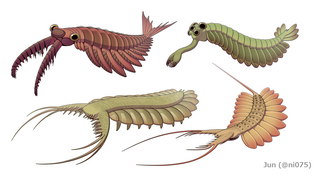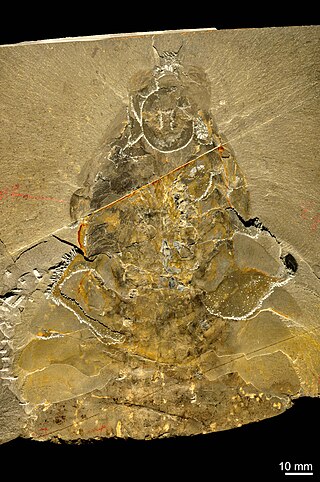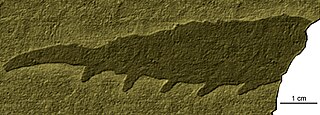
Lobopodians are members of the informal group Lobopodia, or the formally erected phylum Lobopoda Cavalier-Smith (1998). They are panarthropods with stubby legs called lobopods, a term which may also be used as a common name of this group as well. While the definition of lobopodians may differ between literatures, it usually refers to a group of soft-bodied, marine worm-like fossil panarthropods such as Aysheaia and Hallucigenia.

Opabinia regalis is an extinct, stem group arthropod found in the Middle Cambrian Burgess Shale Lagerstätte of British Columbia. Opabinia was a soft-bodied animal, measuring up to 7 cm in body length, and its segmented trunk had flaps along the sides and a fan-shaped tail. The head shows unusual features: five eyes, a mouth under the head and facing backwards, and a clawed proboscis that probably passed food to the mouth. Opabinia probably lived on the seafloor, using the proboscis to seek out small, soft food. Fewer than twenty good specimens have been described; 3 specimens of Opabinia are known from the Greater Phyllopod bed, where they constitute less than 0.1% of the community.

Dinocaridida is a proposed fossil taxon of basal arthropods that flourished in the Cambrian period with occasional Ordovician and Devonian records. Characterized by a pair of frontal appendages and series of body flaps, the name of Dinocaridids refers to the suggested role of some of these members as the largest marine predators of their time. Dinocaridids are occasionally referred to as the 'AOPK group' by some literatures, as the group compose of Radiodonta, Opabiniidae, and the "gilled lobopodians" Pambdelurion and Kerygmachelidae. It is most likely paraphyletic, with Kerygmachelidae and Pambdelurion more basal than the clade compose of Opabiniidae, Radiodonta and other arthropods.

Anomalocaris is an extinct genus of radiodont, an order of early-diverging stem-group arthropods.

Peytoia is a genus of hurdiid radiodont, an early diverging order of stem-group arthropods, that lived in the Cambrian period, containing two species, Peytoia nathorsti from the Miaolingian of Canada and Peytoia infercambriensis from Poland, dating to Cambrian Stage 3. Its two frontal appendages had long bristle-like spines, it had no fan tail, and its short stalked eyes were behind its large head.

Anomalocarididae is an extinct family of Cambrian radiodonts, a group of stem-group arthropods.

Kerygmachela kierkegaardi is a kerygmachelid gilled lobopodian from the Cambrian Stage 3 aged Sirius Passet Lagerstätte in northern Greenland. Its anatomy strongly suggests that it, along with its relative Pambdelurion whittingtoni, was a close relative of radiodont and euarthropods. The generic name "Kerygmachela" derives from the Greek words Kerygma (proclamation) and Chela (claw), in reference to the flamboyant frontal appendages. The specific name, "kierkegaardi" honors Danish philosopher Søren Kierkegaard.

Pambdelurion is an extinct genus of panarthropod from the Cambrian aged Sirius Passet site in northern Greenland. Like the morphologically similar Kerygmachela from the same locality, Pambdelurion is thought to be closely related to arthropods, combining characteristics of "lobopodians" with those of primitive arthropods.

Branchiocaris is an extinct genus of Cambrian bivalved arthropod. The type and best known species, Branchiocaris pretiosa, was described from the Burgess Shale of British Columbia, Canada, in 1929, originally placed in Protocaris, and was placed into its own distinct genus by Briggs in 1976. Several other possible species have been described from Cambrian deposits in China, and it is also possibly known from Cambrian deposits in Utah. Branchiocaris pretiosa is around 80–90 millimetres (3.1–3.5 in) in length, with a highly segmented trunk, consisting of at least 44 ring-like segments, terminating in a forked tail telson. At the front of the animal is a pair of short segmented tapered antennules with at least 20 segments, as well as a pair of claw appendages. It was likely an active swimmer, and used the claw appendages to bring food to the mouth.

Radiodonta is an extinct order of stem-group arthropods that was successful worldwide during the Cambrian period. They may be referred to as radiodonts, radiodontans, radiodontids, anomalocarids, or anomalocaridids, although the last two originally refer to the family Anomalocarididae, which previously included all species of this order but is now restricted to only a few species. Radiodonts are distinguished by their distinctive frontal appendages, which are morphologically diverse and used for a variety of functions. Radiodonts included the earliest large predators known, but they also included sediment sifters and filter feeders. Some of the most famous species of radiodonts are the Cambrian taxa Anomalocaris canadensis, Hurdia victoria, Peytoia nathorsti, Titanokorys gainessii, Cambroraster falcatus and Amplectobelua symbrachiata, the Ordovician Aegirocassis benmoulai and the Devonian Schinderhannes bartelsi.

Hurdia is an extinct genus of hurdiid radiodont that lived 505 million years ago during the Cambrian Period. Fossils have been found in North America, China and the Czech Republic.

Caryosyntrips ("nutcracker") is an extinct genus of stem-arthropod which known from Canada, United States and Spain during the middle Cambrian.

Diania is an extinct genus of lobopodian panarthropod found in the Lower Cambrian Maotianshan shale of China, represented by a single species - D. cactiformis. Known during its investigation by the nickname "walking cactus", this organism belongs to a group known as the armoured lobopodians, and has a simple worm-like body with robust, spiny legs. Initially, the legs were thought to have a jointed exoskeleton and Diania was suggested to be evolutionarily close to early arthropods, but many later studies have rejected this interpretation.

Tamisiocaris is a radiodont genus initially only known from frontal appendages from the Cambrian Sirius Passet lagerstatte in northern Greenland. It was initially described initially in 2010. Further study in 2014 revealed that the frontal appendages were segmented and bore densely-packed auxiliary spines, which were adapted to suspension feeding in a manner analogous to modern baleen whales. It is assigned to the family Tamisiocarididae, and is measured about 34 cm (1.12 ft) long in total body length.

Mureropodia is an animal that existed in what is now the Valdemiedes Formation of Spain during the early Cambrian period. It was described by José Antonio Gámez Vintaned, Eladio Liñán and Andrey Yu. Zhuravlev in 2011, and the type and only species is M. apae.

Amplectobeluidae is a clade of Cambrian radiodonts. It currently includes five definitive genera, Amplectobelua, Lyrarapax, Ramskoeldia, Guanshancaris and a currently unnamed genus from the lower Cambrian aged Sirius Passet site in Greenland. There is also a potential fifth genus, Houcaris, but that genus has become problematic in terms of its taxonomic placement.

Megadictyon is a genus of Cambrian lobopodian with similarities to Jianshanopodia and Siberion. Occasionally mis-spelt Magadictyon.

Houcaris is a possibly paraphyletic radiodont genus, tentatively assigned to Tamisiocarididae, known from Cambrian Series 2 of China and the United States. It contains two species, Houcaris saron and Houcaris magnabasis, both of which were originally named as species of the related genus Anomalocaris. The genus Houcaris was established for the two species in 2021 and honors Hou Xianguang, who had discovered and named the type species Anomalocaris saron in 1995 along with his colleagues Jan Bergström and Per E. Ahlberg.
Luolishania is an extinct genus of lobopodian panarthropod and known from the Lower Cambrian Chiungchussu Formation of the Chengjiang County, Yunnan Province, China. A monotypic genus, it contains one species Luolishania longicruris. It was discovered and described by Hou Xian-Guang and Chen Jun-Yuan in 1989. It is one of the superarmoured Cambrian lobopodians suspected to be either an intermediate form in the origin of velvet worms (Onychophora) or basal to at least Tardigrada and Arthropoda. It is the basis of the family name Luolishaniidae, which also include other related lobopods such as Acinocricus, Collinsium, Facivermis, and Ovatiovermis. Along with Microdictyon, it is the first lobopodian fossil discovered from China.

Laminacaris is a genus of extinct stem-group arthropods (Radiodonta) that lived during the Cambrian period. It is monotypic with a single species Laminacaris chimera, the fossil of which was described from the Chengjiang biota of China in 2018. Around the same time, two specimens that were similar or of the same species were discovered at the Kinzers Formation in Pennsylvania, USA. The first specimens from China were three frontal appendages, without the other body parts.






















